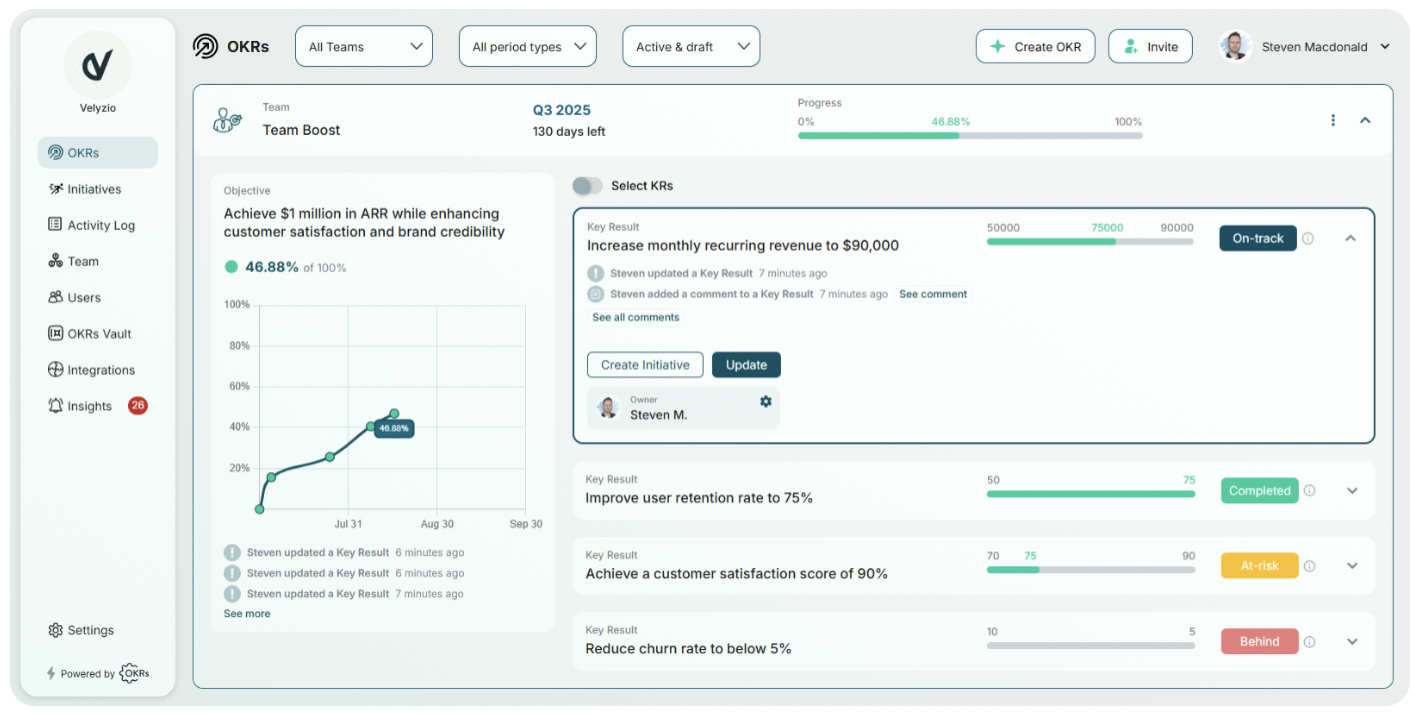Software development teams move faster than any other function in a startup.
Sprints end in days, not quarters. Priorities shift with every customer insight or release. In that kind of environment, static goal-setting systems - like spreadsheets or bloated dashboards - can’t keep up.
Enter OKRs - the framework built for alignment and focus.
Done right, they help software and product teams align around impact, not activity. But only if the tools they use are built for the way developers actually work - async, data-driven, and iteration-heavy.
This list highlights the best OKR software for software development and engineering teams - tools designed for clarity, alignment, and momentum without adding process overhead.
What Makes an OKR Tool Work for Developers
The best OKR platforms for dev teams don’t feel like HR software. They feel like a natural extension of your sprint rhythm. Here’s what to look for:
- Async-friendly collaboration: Developers work across time zones and often in deep-focus blocks. OKR updates should fit that rhythm - not interrupt it. Look for tools that support async check-ins and lightweight updates.
- Integrations with developer tools: The OKR system should live where work happens. Seamless connections to Jira, GitHub, Linear, or Slack prevent context-switching and help keep OKRs relevant.
- Lightweight and fast: If setup feels like implementation hell, adoption will die on day two. The best tools launch in minutes and make it easy to start small.
- Outcome tracking, not task lists: OKRs should show whether your work moved the needle, not just how many tickets got closed. Data and visibility matter more than volume.
- Built for iteration: Good OKR tools help teams learn from each cycle. Retrospectives, AI insights, and trend analysis keep improvement continuous.
But with dozens of platforms on the market, not all OKR tools are created equal. Some are perfect for lean, fast-moving engineering squads; others are built for structured, multi-team alignment.
Top 3 OKR Platforms for Software Teams
Here’s a quick snapshot of the three platforms software teams consistently rate highest - based on usability, setup speed, and developer fit.
Together, these three tools represent the spectrum of what’s working in OKRs right now - from lightweight startup tools to structured enterprise systems.
Best OKR Software Tools for Software Development Teams
If you’re ready to pick your platform, here’s how each one stacks up - starting with the one built specifically for fast-moving dev teams.
1. OKRs Tool - #1 Pick for Fast-Moving Software Teams

OKRs Tool was built for startups and development teams that need alignment without bureaucracy. It turns OKRs into a simple rhythm - a short weekly update, a clear dashboard, and real progress visibility.
The setup takes minutes, not hours, and the pricing model is built for inclusion: free for up to 10 users, then just $30/month flat. This means every developer, PM, or designer can participate without running into per-seat paywalls.
Where it really shines is usability. Teams can draft OKRs with AI assistance, link initiatives to key results, and see weekly momentum at a glance. It’s designed for small to mid-sized teams that want real outcomes, not more meetings.
Best for: Agile software teams and startups that need clarity without complexity.
💡 Fun fact: Over 40% of all new OKRs Tool customers are software development teams - using it to align sprints, releases, and engineering priorities without slowing down.
2. Tability - Best for Agile Product Teams

Tability blends OKR tracking with agile thinking. It’s visual, intuitive, and helps teams focus on progress over process. Developers and PMs can update OKRs asynchronously, using templates and progress snapshots to communicate outcomes.
The platform integrates with Slack, Jira, and other collaboration tools, keeping updates visible where work already happens. AI summaries help turn messy updates into readable status reports - a useful touch for distributed product squads.
Tability works best for teams that already have a clear rhythm of weekly check-ins and sprints, but want a more visible, shared OKR layer on top.
Best for: Product-led teams that want light structure and great visuals.
3. Weekdone - Best for Teams That Thrive on Check-Ins

Weekdone takes OKR rhythm seriously. It’s built around weekly check-ins, summaries, and dashboards that show who’s on track, who’s stuck, and where blockers are forming.
It’s a great fit for teams that value habit-building and transparency. Managers can spot engagement trends early, while developers can share progress asynchronously. Weekdone’s visuals make it easy to digest performance at a glance.
While its feature set skews toward smaller organizations, it’s a solid upgrade from spreadsheets for teams establishing their first OKR cadence.
Best for: Startups and small dev teams ready to build OKR habits.
4. Perdoo - Best for Strategy-to-Execution Alignment

Perdoo focuses on alignment at scale. It connects company strategy, OKRs, and KPIs in one visual framework - ideal for larger software companies that need to manage alignment across product, engineering, and customer success.
Its “Strategy Map” view helps teams visualize how engineering goals ladder up to broader company outcomes. Reporting and analytics are strong, but setup takes time.
Best for: SaaS organizations connecting strategy and product delivery.
5. ClickUp - Best for All-in-One PM + OKR Tracking

ClickUp is a productivity hub that now supports OKRs alongside tasks, docs, and dashboards. It’s not a dedicated OKR tool - but for teams already managing sprints in ClickUp, the native goal-tracking tool is a natural extension.
Teams can link OKRs to tasks and measure progress automatically, reducing manual updates. The trade-off is complexity: with so many features, setup can feel overwhelming without a defined OKR structure.
Best for: Software teams already running sprints in ClickUp.
6. Profit.co - Best for Data-Driven Engineering Teams

Profit.co is built for teams that love dashboards. It provides advanced OKR tracking, KPI integration, and structured review cycles, all in one package.
Engineering and product teams benefit from its detailed metrics and automated progress tracking. However, it can feel rigid for smaller or fast-moving teams. Implementation requires thoughtful configuration to get real value.
Best for: Engineering departments at mid-sized or large companies.
7. Oboard - Best for Teams Aligning OKRs With Product Delivery

Oboard bridges the gap between strategy and execution. It connects OKRs with real delivery data - think sprint boards, feature milestones, or Jira tickets - to give teams visibility into how work drives outcomes.
It’s visual and agile-friendly, showing OKRs alongside progress indicators without extra management overhead. Oboard suits teams that want to see the link between “what we build” and “why it matters.”
Best for: Software teams aligning engineering delivery to strategic goals.
8. Quantive - Best for Enterprise SaaS Companies

Quantive is a powerful OKR and performance platform that integrates with hundreds of data sources. For enterprise engineering organizations with complex reporting needs, it offers unmatched automation.
Dashboards pull live data from tools like Jira, Salesforce, and GitHub to update OKRs automatically. The result: real-time progress visibility at scale. The downside? Price and complexity - this isn’t built for small teams.
Best for: Enterprise SaaS companies managing hundreds of OKRs.
9. Lattice - Best for Tech-Oriented Enterprises With HR Overlap

Lattice brings OKRs into the same platform as performance reviews, feedback, and engagement. For tech companies already running people processes in Lattice, its OKR features close the loop between performance and outcomes.
While not built specifically for developers, it’s strong for organizations that want a single system for people, goals, and growth. Implementation takes time, but it scales well across departments.
Best for: Established tech companies that already use Lattice HR tools.
At a Glance: Best OKR Tools for Software Teams
Here’s how the leading OKR platforms compare for software development and product teams:
Most OKR tools overlap on the basics - creating objectives, linking key results, and visualizing progress. Where they differ is in pricing, setup speed, and fit.
For dev teams and startups, lightweight design and async usability matter more than enterprise analytics.
The Right Tool Keeps You Shipping
The best OKR software for software development teams isn’t about dashboards or metrics - it’s about momentum.
Engineering and product teams thrive when goals stay visible, measurable, and simple to update between releases. The wrong tool adds process friction; the right one reinforces focus and flow.
The ideal OKR platform for developers mirrors how they already work: fast, async, and iterative. It should fit naturally into sprint rhythms, not fight against them.
Whether you’re tracking features, uptime, or impact, the goal is the same - to keep progress transparent and meaningful.
For teams building software in real time, OKRs aren’t a quarterly ritual — they’re a continuous feedback loop that keeps code and strategy in sync.






